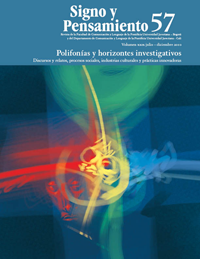Abstract
Based on some authors’ analyses of the terms video, virtual, and real, and the ways in which they converge in visual productions on the web, we examine what in actual fact constitutes a video in that space; Internet is considered a source of information which, in many cases, is visualized as video. It is assumed that such information presents many variables that, in the end, define the way in which it is to be presented; there are variables which can not be precisely assessed, thus turning the unpredictable factors into an actual editor of the information shown on Internet via a video signal.
Brogle, B. y Zimmermann, P. (2003), One Word Movie [en línea], disponible en: http://www. onewordmovie.ch, recuperado: 14 de agosto de 2010.
Charalambos, G. (s. f.), Historia del videoarte en Colombia [en línea], disponible en: http://bitio. net/vac/, recuperado: 14 de agosto de 2010.
Cogua, C.; Lopez, J. A., y Piedrahita, A. (2010), Videored [en línea], disponible en: http:// videored.org, recuperado: 14 de agosto de 2010.
Lévy, P. (1999), ¿Qué es lo virtual?, Barcelona, Paidós. Manovich, L. (2002), “Soft Cinema: Navigating the Database” [pieza artística], expuesta en: ZKM, Karlsruhe.
Maria, W. de (1977), “The Lightining Field” [pieza artística], expuesta en: Catron County, Nuevo México.
McCoy, J. y McCoy, K. (2001), “Every Shot Every Episode” [pieza artística], expuesta en: Technically Engaged, a.i.r Gallery, Nueva York.
Mensvoort, K. van (2004), “Datafountain” [pieza artística], expuesta en: 10 Years Sandberg Design Expo, Edificio Post cs, Amsterdam.
Merleau-Ponty, M. (1964), L’oeil et l’Esprit, París, Gallimard.
Paik, N. J. (1963), “Random Access” [pieza artística], expuesta en: Exposition of Music – Electronic Television, Galerie Parnass, Wuppertal.
Peltz, D. (2005), “risd.tv”, [en línea], disponible en: http://www.risd.tv, recuperado: 14 de agosto de 2010.
Shaw, J. et al. (1996), “Configuring the cave” [pieza artística], expuesta en: Ntt InterCommunication Center, Tokio.
Ugarte, D. de (2007), El poder de las redes deUgarte. com [en línea], disponible en: http://www.deugarte.com/manual-ilustrado-para-ciberactivistas, recuperado: 14 de abril de 2010.
Virilio, P. (1999), La bomba informática, Madrid, Cátedra.
This journal is registered under a Creative Commons Attribution 4.0 International Public License. Thus, this work may be reproduced, distributed, and publicly shared in digital format, as long as the names of the authors and Pontificia Universidad Javeriana are acknowledged. Others are allowed to quote, adapt, transform, auto-archive, republish, and create based on this material, for any purpose (even commercial ones), provided the authorship is duly acknowledged, a link to the original work is provided, and it is specified if changes have been made. Pontificia Universidad Javeriana does not hold the rights of published works and the authors are solely responsible for the contents of their works; they keep the moral, intellectual, privacy, and publicity rights.
Approving the intervention of the work (review, copy-editing, translation, layout) and the following outreach, are granted through an use license and not through an assignment of rights. This means the journal and Pontificia Universidad Javeriana cannot be held responsible for any ethical malpractice by the authors. As a consequence of the protection granted by the use license, the journal is not required to publish recantations or modify information already published, unless the errata stems from the editorial management process. Publishing contents in this journal does not generate royalties for contributors.


